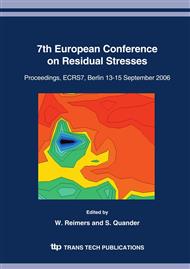p.153
p.161
p.167
p.173
p.179
p.185
p.193
p.199
p.205
Experimental and FEM Analysis of Cutting Sequence on Residual Stresses in Machined Layers of AISI 316L Steel
Abstract:
The reliability of a mechanical component depends to a large extent on the physical state of its surface layers. This state includes the distribution of residual stresses induced by machining. Residual stresses in the machined surface and subsurface are affected by the cutting tool, work material, contact conditions on the interfaces, cutting regime parameters (cutting speed, feed and depth of cut), but also depends on the cutting procedure. In this paper, the effects of cutting sequence on the residual stress distribution in the machined surface of AISI 316L steel are experimentally and numerically investigated. In the former case, the X-ray diffraction technique is applied, while in the latter an elastic-viscoplastic FEM formulation is implemented. The results show that sequential cut tends to increase superficial residual stresses. A greater variation in residual stresses is observed between the first and the second cut. Moreover, an increase in the thickness of the tensile layer is also observed with the number of cuts, this difference also being greater between the first and the second cut. Based on these results, the residual stress distribution on the affected machined layers can be controlled by optimizing the cutting sequence.
Info:
Periodical:
Pages:
179-184
Citation:
Online since:
September 2006
Authors:
Price:
Сopyright:
© 2006 Trans Tech Publications Ltd. All Rights Reserved
Share:
Citation:


